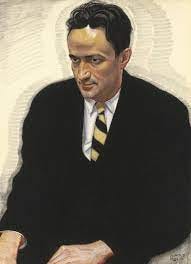LitFlash: "Crimson Gardens. Hurrah!"
The extraordinary Modernist novel Cane, Jean Toomer’s best-known creation, turns 100 this year. It’s a work of rich inventiveness and variety, and a kaleidoscopic meditation on race. In this segment, called ‘Bona and Paul,’ a group of college students in Chicago enters the nightclub Crimson Gardens…
Cane (1923)
People had watched them enter. Had leaned towards each other over ash-smeared tablecloths and highballs and whispered: What is he, a Spaniard, an Indian, an Italian, a Mexican, a Hindu, or a Japanese? Art had at first fidgeted under their stares...what are you looking at, you godam pack of owl-eyed hyenas?...but soon settled into his fuss with Helen, and forgot them. A strange thing happened to Paul. Suddenly he knew that he was apart from the people around him. Apart from the pain which they had unconsciously caused. Suddenly he knew that people saw, not attractiveness in his dark skin, but difference. Their stares, giving him to himself, filled something long empty within him, and were like green blades sprouting into his consciousness.
Drawing of Jean Toomer by Winold Reiss (c. 1925), National Portrait Gallery
About the Author
Jean Toomer (1894-1967) was an American poet and novelist and one of the key figures of the Harlem Renaissance, although his relationship to it and to his own racial background was complicated and shifting. Cane has been heralded by leading scholars of African American literature as “the most original work of literature” to emerge from the Harlem Renaissance. Its experimental form, combined with its unflinching depiction of racism and its circular movement from the rural deep South to Chicago and the Northeast and back, directly inspired and influenced leading contemporary writers including Zora Neale Hurston and Langston Hughes.
Soon after the publication of Cane, Toomer abandoned fiction in order to devote himself to the teachings of Gurdjieff, whose internationally recognized system of psychological transformation, the Harmonious Development of Man, explored fundamental questions about humanity and selfhood through dance, gymnastics, and other physical movement.
Toomer eventually became a Quaker. He died in obscurity but his self-styled “swan song”, Cane, was reissued in 1969, to widespread critical acclaim.
You can read Cane on Project Gutenberg: https://gutenberg.org/cache/epub/60093/pg60093-images.html
You can read some of Toomer’s poetry at the Poetry Foundation:
https://www.poetryfoundation.org/poets/jean-toomer
Suggest a LitHit!
Tell us your own favourites from literature you've read, and we can feature you as a Guest Curator. Just email us with the following information:
Your full name
The title of the book you're suggesting
The location of the excerpt within the book (e.g., "in the middle of chapter 5"), or the excerpt itself copied into the email or attached to it (in Word)
Why you love it, in just a few sentences
About LitHits
LitHits helps you make time for reading by bringing you unabridged excerpts from brilliant literature that you can read on the go, anytime or any place. Our curators carefully select and frame each excerpt so that you can dive right in. We are more than a book recommendation site: we connect you with a powerful, enduring piece of literature, served directly to your mobile phone, tablet or computer.
You might also enjoy...
Feedback
We'd love to hear your thoughts on our newsletter:
kshepherdb@yahoo.co.uk
Graphic design by Sara Azmy
All curation content © 2023 LitHits. All rights reserved.



